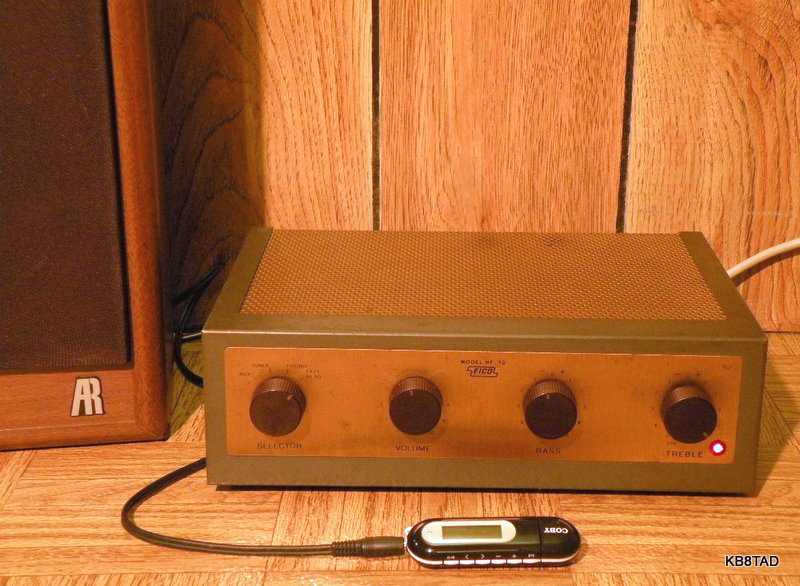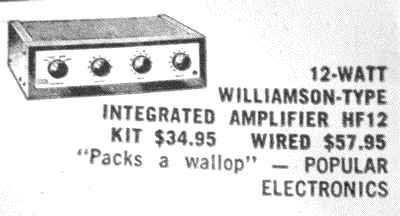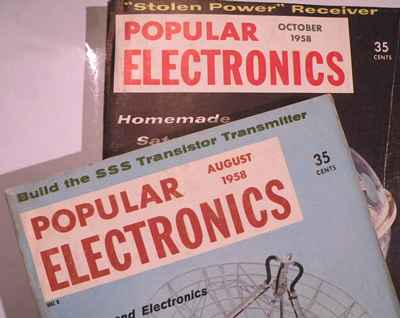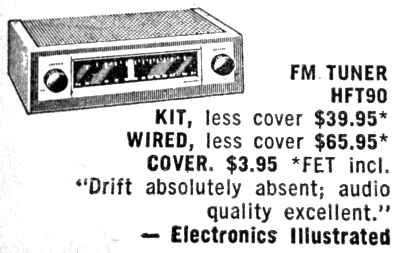
As is obvious from these pages, I occasionally enjoy working on tube audio amps as well as more typical boatanchors. Eico power amps in the HF- series were well designed and very successful as kits. This HF-12 amp was introduced in 1957 as a Williamson-type integrated amplifier. It uses push-pull 6BQ5/ EL-84 tubes and cathode self-bias for 12 watts RMS output. A trio of 12AX7/ ECC83 provide pre-amplification, tone control and phase inverter service. Rectifier is a 6CA4/EZ81.



I purchased the HF-12 amp and its companion HFT-90 tuner at a recycle shop, condition unknown.
Initial checks
I always check an amp or radio with an analog VOM meter before doing any powered tests. Those checks include looking for any line to chassis leakage and checking for a proper high level of resistance between B+ feeds and the chassis.
On an amp or a radio with a separate speaker, I connect a speaker and then check for continuity between the B+ line and the plate of the output tube or tubes. Since one of the 6BQ5 tubes looked like it had seen rough service or heavy use, this was one of my first tests.
Open output transformer
An analog VOM on the low ohms setting with the prods touching the B+ line or the screen grid and the plate of an output tube will cause a crackling sound in the speaker if the output transformer primary winding(s) is intact and a speaker is connected properly. Lack of such noise is an immediate cause to find out why. That is the reason I discovered that one-half of the push-pull output transformer primary was open circuit.
That would also mean that the 6BQ5 output tube on one side of the push-pull pair was likely dead because the screen grid would have tried to take all the current flow in the tube and either have burned out or shorted. The tube did indeed fail a tube tester shorts test. Of course, a shorted tube could also have caused the transformer primary to burn out. Whether a bad tube caused the open transformer primary or the open transformer primary caused the tube to go bad, I do not know.
The output transformer in the HF-12 is fairly unique in size and no replacement was available so I shelved the amp for a time. At a recent swap meet, I found a transformer that would fit properly and have the right primary impedance. However, it only had one 4 ohm secondary in place of the usual 4, 8 and 16 ohm outputs. I decided to install that transformer since an exact replacement was unlikely to be found. Since no new holes were needed, a swap could always be made at a later date if a proper replacement could be found.
Repairs
I installed the replacement output transfomer and a pair of known-good identical 6BQ5 tubes. I also used deoxit on all the controls and the tube sockets. Coupling caps were checked and replaced as needed. This was followed by a slow power up while monitoring voltage and current draw. The electrolytics reformed quickly. The 6CA4 rectifier is a very good choice since it delays B+ until the tubes warm up. I injected a signal and confirmed that the amp was working properly.
I then fed the amp with my MP3 player. Although the amp was working well, the B+ was a bit high for my taste, measuring at 374 volts when my isolated variac was feeding the full line voltage of 120. There was also some hum when the volume control was turned up and the amp switched to the magnetic phono or tape-head inputs.
Grounding the chassis stopped nearly all of the hum. Adjusting the hum balance control stopped the rest. I decided that a 3-wire cord replacement would not only be a safety improvement but would provide a permanent solution to a hum problem.
Reducing B+ voltage
Although I was not sure what Eico had intended the B+ voltage to be, I decided that 374 volts was too much. Quiescent line current draw was about 0.57 amps. Given today's higher line voltage as well as the price of tube replacement, I decided to follow the RCA tube manual recommendation of 300 volts by adding a choke input. A choke would not only reduce the B+ but also help with filtering and actually allow the power transformer to provide a bit more current.
Rather than wire the choke into the high voltage lead from the rectifier, I opted to connect it between the B- return and the chassis. I unsoldered the power transformer's high voltage center tap from its chassis connection and tested the result of adding a choke from my "junk" box. A 5 Henry choke dropped B+ to about 260. A smaller value choke of about 0.6 Henry dropped it to 332. I installed that smaller choke and also added a 350 ohm resistor in the B- lead to bring the B+ voltage down to 300. Line current draw was reduced to 0.48 amp.
After these repairs and modifications, I ran the amp for over an hour playing music from an MP3 player while occasionally checking the temperature of the power transformer. After an hour the transformer had heated up but not overly so.
While the single 4 ohm output was a bit of a limitation, I simply fed two 8 ohm speakers with the amp. Not surprisingly, it easily drove my two Acoustic Research SB-8b speakers to more volume than I could stand.


Eico HFT-90 tuner
The matching Eico HFT-90 tuner did not need much repair. Cleaning of its power switch and volume control and a minor alignment tweak resulted in a decent performing FM tuner. I love the Eico miniature vacuum tube dial pointer that varies the height of its lighted area based on the strength of the received signal! (See the blue lighted pointer in the picture below.) Definitely a unique use of a vacuum tube. Although the tuner certainly lacks some of the sensitivity of later high-end solid-state FM receivers and is limited to monaural, it is fun to use for stronger stations or with a good antenna.

Follow up, locating the manuals
After completing the repairs and modifications, I was able to find the full manuals for both the amp and tuner on-line. Both the tuner and the amp can be found at Abeltronics in the UK along with a variety of other audio manuals.
The amp manual can also be found at the Blackburn Audio site.
Both of these websites are excellent resources.
The manual for the amp shows that Eico intended the B+ to be 330 volts. Therefore just the small choke would be enough to reduce the voltage. However, I will follow the RCA tube manual recommendations for now. Returning to a higher voltage is as simple as shorting out the added resistor, something that could be done with a simple SPST switch for times when either lower or higher voltage is desired.
10-30-09
The Knight-Kit "Star Roamer" Receiver was the previous item on the bench.